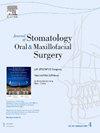Facing a new reality: Significant increase in necrotizing fasciitis in the post-COVID era?
IF 1.8
3区 医学
Q2 DENTISTRY, ORAL SURGERY & MEDICINE
Journal of Stomatology Oral and Maxillofacial Surgery
Pub Date : 2024-11-13
DOI:10.1016/j.jormas.2024.102145
引用次数: 0
Abstract
Background
Necrotizing fasciitis (NF) is a rare, rapidly progressing soft tissue infection characterized by the widespread necrosis of fascial planes and surrounding tissues.
Material and methods
We discuss four consecutive necrotizing fasciitis cases of the head and neck region, that accrued in a time window of 6 months. Patient demographics, clinical features, laboratory analyses, imaging findings, surgical interventions, and outcome were collected, assessed and discussed. These findings were checked against recent epidemiological data of invasive Group A Streptococcus (iGAS) in Europe.
Results
Four patients (two males and two females) aged between 31 and 65 years were included. The most common presenting symptom was severe pain and facial swelling (100 %), followed by fever (50 %) and erythema (50 %). All patients underwent emergency surgical debridement, and broad-spectrum antimicrobial therapy was initiated promptly. Streptococcus pyogenes was isolated in every patient. Three patients required multiple debridement procedures, and one case necessitated extensive neck resection due to the involvement of deeper structures. Overall, two patients recovered with no to minor residual deficits, one patient experienced persistent trismus and one patient passed away due to septic shock and multiorgan failure.
Conclusion
Prevalence of iGAS infections have increased in European countries, therefore increased vigilance is recommended so that a quick diagnosis can be established and appropriate treatment can be administered to avoid serious morbidity and mortality.
面对新现实:后科维德时代坏死性筋膜炎病例大幅增加?
背景:坏死性筋膜炎(NF坏死性筋膜炎(NF)是一种罕见的、进展迅速的软组织感染,其特点是筋膜平面和周围组织广泛坏死:我们讨论了在 6 个月内连续发生的 4 例头颈部坏死性筋膜炎病例。我们收集、评估并讨论了患者的人口统计学特征、临床特征、实验室分析、影像学检查结果、手术干预和治疗效果。这些结果与欧洲侵袭性 A 群链球菌(iGAS)的最新流行病学数据进行了核对:共纳入四名患者(两男两女),年龄在 31 岁至 65 岁之间。最常见的首发症状是剧烈疼痛和面部肿胀(100%),其次是发热(50%)和红斑(50%)。所有患者均接受了急诊手术清创,并迅速开始了广谱抗菌治疗。每位患者都分离出了化脓性链球菌。三名患者需要进行多次清创手术,其中一例患者因累及深层结构而需要进行大面积颈部切除术。总的来说,两名患者痊愈后没有或仅有轻微的后遗症,一名患者出现持续性三足畸形,一名患者因脓毒性休克和多器官功能衰竭而去世:结论:iGAS 感染在欧洲国家的发病率有所上升,因此建议提高警惕,以便快速确诊并进行适当治疗,避免严重的发病率和死亡率。
本文章由计算机程序翻译,如有差异,请以英文原文为准。
求助全文
约1分钟内获得全文
求助全文
来源期刊

Journal of Stomatology Oral and Maxillofacial Surgery
Surgery, Dentistry, Oral Surgery and Medicine, Otorhinolaryngology and Facial Plastic Surgery
CiteScore
2.30
自引率
9.10%
发文量
0
审稿时长
23 days
 求助内容:
求助内容: 应助结果提醒方式:
应助结果提醒方式:


